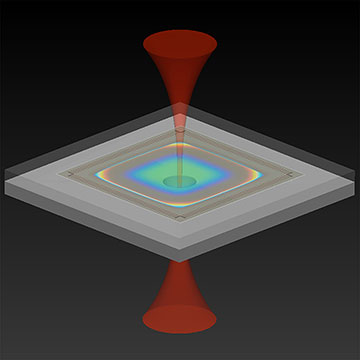
Illustration of the NIST optomechanical accelerometer, which uses light to measure acceleration. [Image: F. Zhou, NIST]
From rockets to automotive airbags and structural monitoring, high-precision accelerometers are playing an increasing role in modern technological society. Yet the methods to build and calibrate these devices can limit their resolution and accuracy.
Now, researchers at a U.S. laboratory have built a self-calibrating optomechanical accelerometer that employs a tiny Fabry-Pérot cavity between two silicon chips (Optica, doi: 10.1364/OPTICA.413117). The device, which fits into a steel package a few centimeters in height, exhibits higher accuracy over a broader range of wavelengths than previous optomechanical accelerometers.
Optomechanical nuts and bolts
The team at the U.S. National Institute of Standards and Technology (NIST) designed the accelerometer as two stacked silicon chips mounted inside a steel covering, with an infrared laser beam fed into the bottom chip through a polarization-maintaining optical fiber. The bottom chip contains a tiny hemispherical silicon mirror with a quarter-wave periodic coating; its radius of curvature is about 410 μm. The top chip contains a rectangular proof mass suspended from the rest of the silicon chip by silicon nitride beams. The design permits the mass to move up and down freely in response to the acceleration of the device.
Together, the mirror coating on the proof mass and the hemispherical mirror embedded in the bottom chip form the Fabry-Pérot cavity. When the injected laser light matches the resonant wavelength of the cavity, it builds up until the intensity of the transmitted light equals the input light. Applying an acceleration to the device moves the proof mass vertically and changes the size of the cavity as well as its resonant frequency. This effect alters the intensity of the light output. The mass moves like a simple harmonic oscillator, making it easy to convert its tiny displacements into measurements of acceleration in terms of the laser wavelength.
Sensing applications
The NIST scientists built two versions of the device, one designed for operation at normal room temperature and air pressure and the other one for vacuum conditions. The team carefully measured the displacement noise floor and displacement spectral density in both types of environments.
The researchers predict that future refinements of this device could be applied to force, pressure and gravity sensing as well as acceleration. Perhaps later generations of the optomechanical accelerometer will monitor volcano eruptions or even detect dark matter in the universe.
